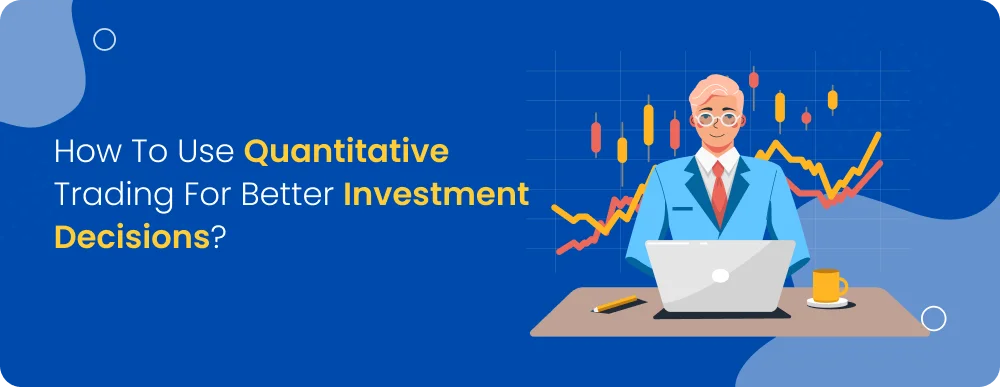How To Use Quantitative Trading For Better Investment Decisions?
Noor Kaur
8 Aug 2025Tags:
Featured
Quantitative trading allows you to make investment decisions based on logic, data, and tested models rather than gut feeling or market noise. By applying quantitative analysis in the stock market, you can identify consistent patterns, manage risk with precision, and optimize portfolio performance.
Whether you're a retail investor or managing larger capital, building a quant-based approach helps remove bias and focus on repeatable outcomes.
What is Quantitative Trading?
Quantitative trading is a method of trading that uses mathematical models, statistical analysis, and algorithmic logic to identify opportunities and execute trades. Unlike discretionary trading, it removes emotional decision-making and relies on hard data, such as price trends, volatility, and historical correlations. Traders using this method, known as “quants,” analyse large datasets to develop systematic trading strategies.
This approach is widely used by hedge funds, institutional investors, and increasingly by retail traders, thanks to accessible tools and programming platforms. At its core, quantitative trading focuses on testing, automating, and scaling strategies that are repeatable and backed by measurable logic.
How Quantitative Trading Strategies Work
Quantitative trading strategies are built on data. These strategies start with a hypothesis (e.g., stocks that rise for 5 days tend to fall on the 6th) and then get tested using historical market data. The goal is to validate whether the idea consistently produces positive returns while managing risk.
Key components of a quant strategy:
Signal Generation: Based on factors like momentum, mean reversion, or statistical relationships.
Risk Management: Uses quantitative risk analysis to control exposure and prevent large drawdowns.
Execution Logic: Orders are placed using algorithms that minimise cost and slippage.
Backtesting: Strategies are validated using past data before going live.
Automation: Many strategies are run automatically using platforms built in Python or R.
Building a Quantitative Trading System
To implement quantitative trading successfully, you need a structured system that handles the full trading cycle:
Data Collection: Gather clean, historical price and volume data. Many use APIs from exchanges or platforms like Quandl and Yahoo Finance.
Strategy Design: Use quantitative analysis to identify trade logic—this could be based on trend signals, mean reversion, or volatility patterns.
Backtesting: Simulate the strategy using historical data to measure profitability, drawdown, win rate, and risk-reward ratio.
Coding and Automation: Code your strategy using platforms like Backtrader or QuantConnect. Python is the most common choice for this step.
Execution and Monitoring: Deploy the strategy live. Use automated systems to execute orders, manage positions, and monitor performance in real time.
Optimisation and Scaling: Continuously refine based on performance data. Test across markets and timeframes. Use AI quantitative trading techniques to adapt to new patterns.
Benefits of Quantitative Analysis in Stock Market Investing
Quantitative analysis in the stock market helps investors make decisions based on facts, not opinions. By using historical data, pricing models, and statistical indicators, investors can create more consistent and objective strategies.
Key benefits include:
Data-Driven Decisions: Reduces emotional bias by relying on measurable patterns.
Backtesting Capability: Strategies can be tested against historical data to estimate their performance before going live.
Scalability: Once a model works, it can be applied across multiple stocks or asset classes.
Diversification: Quantitative filters help build diversified portfolios based on factors like volatility, correlation, and trend strength.
Speed and Efficiency: Algorithms can scan thousands of stocks in minutes, identifying opportunities faster than manual screening.
Suggested Read: Importance of Data Quality in Algo Backtesting
Incorporating Quantitative Risk Analysis
Quantitative risk analysis is a key part of any reliable trading system. It helps you understand, control, and limit potential losses using objective metrics.
You can incorporate it by:
Defining Position Sizing Rules: Allocate capital based on volatility or historical drawdowns.
Setting Stop-Loss and Target Levels: Based on probability or price action models.
Tracking Metrics: Use Sharpe Ratio, maximum drawdown, and win rate to assess risk-adjusted performance.
Stress Testing: Simulate how strategies behave in extreme conditions (e.g., sudden crashes or high volatility).
Dynamic Adjustments: Algorithms can scale back exposure when risk exceeds pre-set thresholds.
Challenges of Quantitative Trading
Despite its benefits, quantitative trading comes with technical and practical challenges:
Data Quality Issues: Inaccurate or missing data can lead to faulty backtests and poor strategy design.
Overfitting: Creating a model that works perfectly on historical data but fails in real markets.
Market Changes: Strategies that once worked may break down due to regulatory changes or shifts in market behaviour.
Infrastructure Requirements: Building and maintaining systems (especially for high-frequency strategies) requires strong tech skills and resources.
Execution Risk: Slippage, latency, and poor order routing can reduce real-world profitability.
High Competition: Many quantitative trading strategies are widely used, making it harder to maintain an edge over time.
Role of AI in Quantitative Trading
Artificial Intelligence (AI) is playing an increasingly important role in quantitative trading, helping traders go beyond rule-based systems and build models that learn, adapt, and optimise in real time. Traditional quant models rely on fixed logic, but AI-powered systems—especially those using machine learning—can identify complex, non-linear patterns across large datasets.
Key contributions of AI in quantitative trading include:
Predictive Modelling: AI can process vast amounts of market data—price, volume, news, and even social sentiment to forecast short-term price movements more accurately than manual models.
Dynamic Strategy Adjustment: Machine learning models can retrain themselves with new data, allowing strategies to adjust as market conditions change.
Anomaly Detection: AI helps flag unusual price or volume activity in real time, reducing execution risk and improving surveillance.
Portfolio Optimisation: AI techniques like reinforcement learning are used to allocate capital across strategies or assets more efficiently, based on expected return and risk.
Execution Algorithms: AI-driven order execution tools optimise how and when to place trades to minimise slippage, avoid detection, and reduce market impact.
Natural Language Processing (NLP): NLP helps extract trading signals from unstructured data sources such as earnings reports, news headlines, or regulatory filings.
Conclusion
Using quantitative trading strategies adds structure and discipline to your investment process. It enables you to filter opportunities with clear rules, test them historically, and apply risk controls backed by data.
With tools like quantitative risk analysis and model-based forecasting, your decisions become less reactive and more strategic. As markets evolve, integrating elements like automation, AI, or even algo trading in Python can further strengthen your long-term investment edge.
FAQs
How does quantitative analysis in the stock market differ from fundamental analysis?
Quantitative analysis in the stock market focuses on numerical data—like price, volume, volatility, and patterns—to make trading decisions. In contrast, fundamental analysis looks at a company’s financials, earnings, and macroeconomic indicators. Quantitative trading uses data-driven models, while fundamental analysis is based on business value and qualitative factors.
How can quantitative models improve trading strategies?
Quantitative models reduce emotional bias by applying rules consistently across trades. They allow traders to backtest ideas, optimise entry and exit points, and adjust position sizing using quantitative risk analysis. These models can also identify patterns not easily visible through manual observation, improving both speed and accuracy in execution.
What are the most common quantitative trading strategies?
Popular quantitative trading strategies include:
Statistical arbitrage: Exploiting price differences between correlated assets.
Mean reversion: Betting prices will return to their average over time.
Momentum: Buying rising assets and selling falling ones.
Pairs trading: Taking opposite positions in two historically correlated stocks.
How do traders use statistical arbitrage?
In statistical arbitrage, traders identify temporary price divergences between correlated assets using quantitative models. Once identified, they simultaneously buy the undervalued asset and sell the overvalued one, expecting both to revert to their typical relationship. It’s one of the most widely used quantitative trading strategies, especially in hedge funds.
What are the best tools for quantitative trading analysis?
Top tools include:
Python & R: For custom strategy development and testing (see “Quantitative Trading: How to Build Your Own Algorithmic Trading Business” for guidance).
Pandas, NumPy, and scikit-learn: For data analysis and machine learning.
QuantConnect, Backtrader, and MetaTrader: For strategy simulation and live trading.
Bloomberg Terminal: For high-quality market data and execution.
Is quantitative trading suitable for day trading or swing trading?
Yes. Quantitative trading can be applied to both. Day traders often use high-frequency models or short-term mean reversion strategies. Swing traders use slightly longer timeframes, focusing on momentum, breakouts, or volatility-based setups. With proper backtesting and risk control, quant models can be tailored to fit either approach.
Noor Kaur
8 Aug 2025Related blogs


What is SME IPOs: Meaning, Differences and How to Apply
Small and medium-sized businesses, also known as SMEs, are crucial for socioeconomic growth in many developing cou...


Evaluating Indian Sectors: Key Investment Factors | mastertrust
A few decades ago, individual investors faced the challenge of getting access to sufficient information. However, ...


India's Investment Landscape: A Comprehensive Guide | mastertrust
Investments in India have consistently outperformed those in other emerging nations.


5 secret benefits of investing in mutual fund
Investing in mutual funds is a strategic move. From diversification of funds to long-term growth, the possibilitie...
Sign up to our newsletter !
Share this article on
Recent articles
Tags:
Open a Demat Account in just 15 minutes !

Click on open
account below

Fill out some
basic details

Upload your
documents

Start trading in
24 Hours *
Commonly asked questions
Is Master Capital Services Limited SEBI registered?
Do you have a mobile app for Trading and Finance Management?
What services does mastertrust provide?
What is the minimum investment required to start trading with your company?
Is my personal and financial information secure with your company?
What is your customer support availability?

